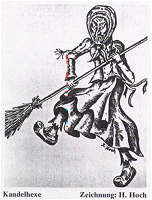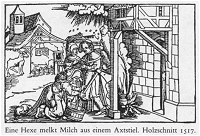Witches in chorus
The witches t'ward the Brocken strain
When the stubble yellow, green the grain.
The rabble rushes - as 'tis meet -
To Sir Urian's lordly seat.
O'er stick and stone we come, by jinks!
The witches f..., the he-goat s...
Voice
Old Baubo comes alone, I see;
Astride on farrow sow is she!
Chorus
So honor be where honor is due!
Dame Baubo first! to lead the crew,
A hag upon a sturdy sow!
All witches come and follow now!
Voice
Which way didst thou come here?
Voice
By Ilsenstein crest;
I peered into an owlet's nest.
Her wild eyes stared at me!
Voice
To hell, I say, with thee!
Why ride so furiously?
Voice
She almost flayed me!
See here, the wounds she made me!
Chorus of Witches
The road is wide, the way is long:
How madly swirls the raving throng
The pitchfork pricks, the broom us hurts;
the infant chokes, its mother bursts.
Wizards. Semi-chorus
We creep as slowly as a snail;
Far, far ahead the witches sail.
When to the Devil's home they speed,
Women by a thousand paces lead.
The Other Half
Not so precise are we! Perhaps
A woman takes a thousand steps.
Although she hastes as best she can,
One leap suffices for a man.
Voice (above)
Come with us from the rockbound lake!
Voices (below)
We fain would follow in your wake!
We've washed, are clean as clean can be;
Yet barren evermore are we.
Both Choruses
The wind is hushed, the starlight pales,
The dismal moon her features veils;
As magic-mad the hosts whiz by,
A myriad sparks spurt forth and fly.
Voice (from below)
Tarry! Tarry!
Voice (from above)
Who calls so loud from rocky quarry?
Voice (from below)
Take me too! Take me too!
Three hundred years I have been striving
To reach the peak - I'm not arriving;
I fain would join my equals too.
Both Choruses
The broomstick carries, so does the stock;
The pitchfork carries, so does the buck;
Who cannot rise on them tonight,
Remains for aye a luckless wight. | HEXEN (im Chor):
Die Hexen zu dem Brocken ziehn,
Die Stoppel ist gelb, die Saat ist grün.
Dort sammelt sich der große Hauf,
Herr Urian sitzt oben auf.
So geht es über Stein und Stock,
Es farzt die Hexe, es stinkt der Bock.
STIMME:
Die alte Baubo kommt allein,
Sie reitet auf einem Mutterschwein.
CHOR:
So Ehre denn, wem Ehre gebührt!
Frau Baubo vor! und angeführt!
Ein tüchtig Schwein und Mutter drauf,
Da folgt der ganze Hexenhauf.
STIMME:
Welchen Weg kommst du her?
STIMME:
Übern Ilsenstein! Da guckt ich der Eule ins Nest hinein,
Die macht ein Paar Augen!
STIMME:
O fahre zur Hölle!
Was reitst du so schnelle!
STIMME:
Mich hat sie geschunden,
Da sieh nur die Wunden!
HEXEN, CHOR:
Der Weg ist breit, der Weg ist lang,
Was ist das für ein toller Drang?
Die Gabel sticht, der Besen kratzt,
Das Kind erstickt, die Mutter platzt.
HEXENMEISTER, HALBER CHOR:
Wir schleichen wie die Schneck im Haus,
Die Weiber alle sind voraus.
Denn, geht es zu des Bösen Haus,
Das Weib hat tausend Schritt voraus.
ANDERE HÄLFTE:
Wir nehmen das nicht so genau,
Mit tausend Schritten macht's die Frau;
Doch wie sie sich auch eilen kann,
Mit einem Sprunge macht's der Mann.
STIMME (oben):
Kommt mit, kommt mit, vom Felsensee!
STIMMEN (von unten):
Wir möchten gerne mit in die Höh.
Wir waschen, und blank sind wir ganz und gar;
Aber auch ewig unfruchtbar.
BEIDE CHÖRE:
Es schweigt der Wind, es flieht der Stern,
Der trübe Mond verbirgt sich gern.
Im Sausen sprüht das Zauberchor
Viel tausend Feuerfunken hervor.
STIMME (von unten):
Halte! Haltet
STIMME (oben):
Wer ruft da aus der Felsenspalte?
STIMME (von unten):
Nehmt mich mit! Nehmt mich mit!
Ich steige schon dreihundert Jahr,
Und kann den Gipfel nicht erreichen
Ich wäre gern bei meinesgleichen.
BEIDE CHÖRE:
Es trägt der Besen, trägt der Stock
Die Gabel trägt, es trägt der Bock
Wer heute sich nicht heben kann
Ist ewig ein verlorner Mann.
|
 Cross Quarter Day May 1 - May Day is closely connected to the evening
before it - the "Walpurgisnacht" or May Eve. Its roots can be found in
pre-Christian Frühjahrsfests. Walpurgisnacht is situated directly
opposite Halloween and is the end marker in the seasonal cycle which
begins with Candlemas/Groundhog Day. Children play pranks on unsuspecting victims around midnight on April 30, similar to Halloween,
and some even dress up as witches and evil spirits. The Brocken,
the highest peak in the Harz Mountains, is known as the mythical meeting
place of the witches. Witches' fires may burn in some places. Since noise
was deemed the most effective way to drive off evil spirits many ways of
making noise are known. On May Day earth spirits like fairies and elves
(the ancient dead) would come out of the hills and barrows to dance on May
Eve and well into the summer.
Cross Quarter Day May 1 - May Day is closely connected to the evening
before it - the "Walpurgisnacht" or May Eve. Its roots can be found in
pre-Christian Frühjahrsfests. Walpurgisnacht is situated directly
opposite Halloween and is the end marker in the seasonal cycle which
begins with Candlemas/Groundhog Day. Children play pranks on unsuspecting victims around midnight on April 30, similar to Halloween,
and some even dress up as witches and evil spirits. The Brocken,
the highest peak in the Harz Mountains, is known as the mythical meeting
place of the witches. Witches' fires may burn in some places. Since noise
was deemed the most effective way to drive off evil spirits many ways of
making noise are known. On May Day earth spirits like fairies and elves
(the ancient dead) would come out of the hills and barrows to dance on May
Eve and well into the summer. The festival is marked by numerous rituals to ward off evil. On the
eve of May 1st the bells toll in Luxembourg and many prayers are said,
there are blessings with holy-water and blessed-palms in the homes and
barns. In Schmalkalden in Thueringen the little girls, dressed as Hexen
themselves, chase out the Walpermännchen. They wear paper hats and
sometimes carry sticks in their hands. Similarly, in the south Harz
region, the young boys ride stick-horses and chase the Hexen out of the
fields. The most widespread remedy against evil spirits during
Walpurgisnacht is noise. The boys begin making noise as soon as the sun
sets. In Bohemia boards are beaten onto the ground in front of the
houses, accompanied by this chant: "Hex geh raus, 's brennt dei Haus."
Whoever hears a pistol shot on that evening is supposed to say, "Schiess
mei Hex a mit!" In Lippe the noise is referred to as "Maiklappen." A lot
of noise is especially made in front of the houses of married couples who
are childless, because it is believed that it is necessary to "further the
blessings." In the Berner Jura the shephard boys, on the eve of May 1,
stand atop the manure-piles and crack whips in order to drive away
wolves. The wolf is the incarnation of evil, and symbolizes the departure
of winter. The manure-pile symbolizes fertility of the fields and
gardens, and therefore is often the locale where prayers are said.
Farmers who don't have as many cattle help each other out in the summer.
They make a pledge-group, which takes this form in Donaueschingen:
they go to a nearby chapel and pray, then they climb together onto a
manure-pile, hold hands, and say "Mir (=wir) gmaren miteinand," which
means "we are helping each other to bring home hay and grain with our
cattle." [i.e. they are sharing each other's manure-piles, which is
sprayed onto the fields as fertilizer].
The festival is marked by numerous rituals to ward off evil. On the
eve of May 1st the bells toll in Luxembourg and many prayers are said,
there are blessings with holy-water and blessed-palms in the homes and
barns. In Schmalkalden in Thueringen the little girls, dressed as Hexen
themselves, chase out the Walpermännchen. They wear paper hats and
sometimes carry sticks in their hands. Similarly, in the south Harz
region, the young boys ride stick-horses and chase the Hexen out of the
fields. The most widespread remedy against evil spirits during
Walpurgisnacht is noise. The boys begin making noise as soon as the sun
sets. In Bohemia boards are beaten onto the ground in front of the
houses, accompanied by this chant: "Hex geh raus, 's brennt dei Haus."
Whoever hears a pistol shot on that evening is supposed to say, "Schiess
mei Hex a mit!" In Lippe the noise is referred to as "Maiklappen." A lot
of noise is especially made in front of the houses of married couples who
are childless, because it is believed that it is necessary to "further the
blessings." In the Berner Jura the shephard boys, on the eve of May 1,
stand atop the manure-piles and crack whips in order to drive away
wolves. The wolf is the incarnation of evil, and symbolizes the departure
of winter. The manure-pile symbolizes fertility of the fields and
gardens, and therefore is often the locale where prayers are said.
Farmers who don't have as many cattle help each other out in the summer.
They make a pledge-group, which takes this form in Donaueschingen:
they go to a nearby chapel and pray, then they climb together onto a
manure-pile, hold hands, and say "Mir (=wir) gmaren miteinand," which
means "we are helping each other to bring home hay and grain with our
cattle." [i.e. they are sharing each other's manure-piles, which is
sprayed onto the fields as fertilizer].